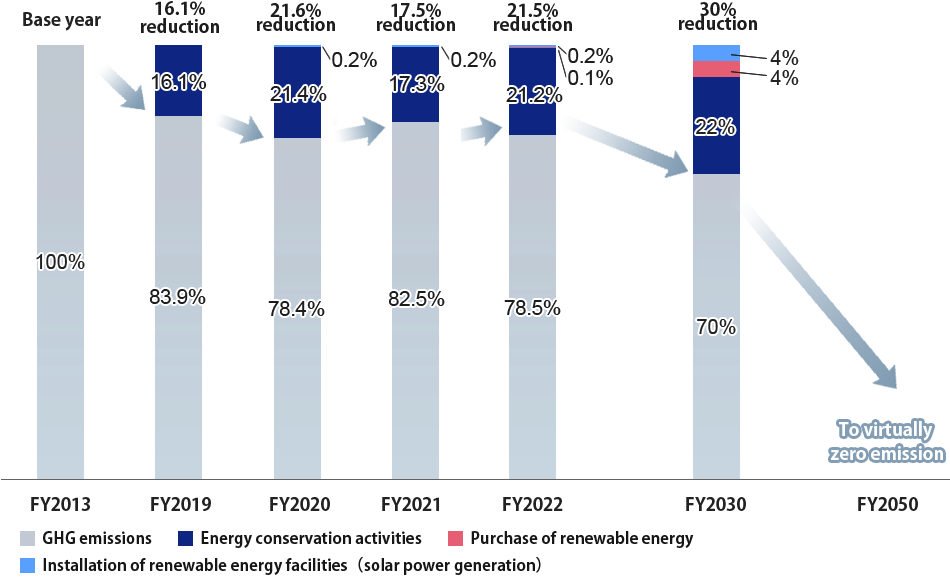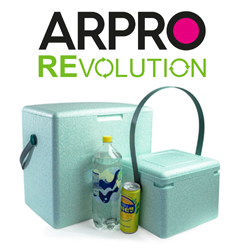
Approach and Activities on Climate Change
While economic development is driven by globalization, environmental issues such as climate change are causing various impacts on the planet, animals and plants, including on our own lives. Based on our corporate philosophy of "Creatively and Actively Contribute to Society”, the JSP Group takes initiative in accepting greater responsibility for the environment as a global company and contributes towards the realization of a sustainable society by providing environmentally and socially friendly products through the development of environmentally friendly technologies with the aim of achieving carbon neutrality by 2050.
Information Disclosures Based on the TCFD Recommendations
JSP declared to support the recommendations of the Task Force on Climate-Related Financial Disclosures (TCFD) in December 2021. JSP sees climate change-related events as a business risk and aims to respond to them while identifying new opportunities to enhance corporate value.
In addition, JSP views the TCFD recommendations as an effective framework for organically and practically promoting activities to realize a sustainable society and will use the TCFD as a tool for dialogue with various stakeholders.
By addressing climate change, JSP aims to increase social and economic value and realize the corporate philosophy of "Creatively and Actively Contribute to Society” as a true global supplier.
Governance and Risk Management
Company-wide Sustainability Promotion Structure

- JSP's response to climate change will be based on the Company-wide Sustainability Promotion Structure.
- Board of Directors, chaired by the President, is responsible for governance and oversees the impact of climate-related issues on management activities.
- Executive Officers Meeting is responsible for managing climate-related risks, carrying out reviews and making decisions on responses.
- In order to consider specific measures on climate change in the Executive Officers Meeting, information on global trends and requests is collected and the situation and risks are analyzed on a cross-functional basis through both sustainability promotion activities and Responsible Care activities.
- Sustainability Promotion Committee, an advisory body to Executive Officers Meeting, is convened to discuss policies and measures to be taken on particularly important issues.
- Sustainability Promotion Department, established in April 2021, serves as the organizer of the Sustainability Promotion Committee and ensures that company-wide sustainability promotion activities including response to climate change function effectively.
- Entire Company refers to business divisions, corporate divisions, plants, research centers, group companies, etc., which implement sustainability promotion activities.
- Specific issues related to reduction of energy consumption and greenhouse gas (GHG) emission are discussed at Responsible Care Meeting, Energy Conservation Promotion Managers Meeting, and Environment Safety Promotion Meeting. Through the establishment of these various meetings, we have set up a system to manage and share essential information on energy and GHG emission reductions.
Strategies
The JSP Group's strategies on climate change are developed by conducting scenario analysis. The JSP Group uses two scenarios: one in which global average temperature increase is limited to 1.5°C above pre-industrial levels (1.5°C scenario) and one in which global average temperature increase is 4°C above pre-industrial levels (4°C scenario). In addition, we assess the impact in business model theoretically derived from the risks and opportunities analyzed based on the scenarios and consider responses.
1. Contribute to climate change mitigation by further promoting environmentally friendly productsAll foamed plastics are resource-saving materials and are "environmentally friendly products" that contribute to reducing environmental impact by reducing CO₂ emissions. Among them, we will contribute to climate change mitigation by positioning products that can make a significant contribution to climate change, national land resilience, and disaster recovery as "climate change-responsive products" and focusing on their widespread use.
2. Contribute to the recycling of plastic resources by promoting recycling activities 3. Contribute to climate change mitigation by reducing GHG emissions and using energy more efficientlyScenario Analysis for Strategy Development
Assumptions for Scenario Analysis- Target Year: FY2030
- Target Entity: JSP Corporation (Non-consolidated)
-
Scenario: Scenario in which global average temperature increase is limited to 1.5°C above pre-industrial levels and scenario in which global average temperature increase is 4°C above pre-industrial levels
※ Scenario analysis was conducted using SSP-1 (sustainable) and SSP-3 (regional fragmentation) from the "Japanese SSP" published by the National Institute for Environmental Studies based on the "Shared Socio-Economic Pathways (SSP)" published by the Intergovernmental Panel on Climate Change (IPCC). - Evaluate the impact of risks and opportunities on the entire business portfolio and develop response strategies
| Transition risk | Impact assessment | Key response | |
| Policy | Increase in carbon prices | Increase in operating costs | Reduce GHG emissions through promotion of energy conservation |
| Promote introduction of renewable energy | |||
| Reduce GHG emissions through logistics optimization | |||
| Introduction of a percentage standard for the use of recycled resources | Increase in costs caused by competition for recycled raw materials | Diversify recycled raw materials suppliers | |
| Enhance development of products using recycled raw materials | |||
| Technology | Increased competition with competing materials | Deterioration in earnings of existing products | Further promotion of material recycling |
| Work on chemical recycling as an industry organization | |||
| Assess and reduce environmental impact (GHG emissions, water consumption, etc.) and communicate information | |||
| Promote development of bio-based products | |||
| Market/Reputation | Sudden fluctuations in raw material prices and formation of negative image of fossil-based raw materials | Deterioration in earnings of existing businesses | Further promotion of material recycling |
| Strengthen communication of information on GHG emission reductions through climate change-responsive products | |||
| Strengthen communication of information on environmentally friendly products | |||
| Assess product life cycle and strengthen communication of information | |||
| Enhance establishment of recycling chains | |||
| Opportunity | Opportunity product |
| Increased demand for products that contribute to energy savings in housing | MIRAFOAM、MIRAFOAM Λ |
| Expansion of the market for recycled products | ARPRO RE、ARPRO RE OCEAN、ARPRO REvolution |
| Increased demand for lightweight components due to expansion of the EV market | ARPRO/P-BLOCK、P-BLOCK LC |
| Increased demand for bio-based products | MIRABLOCK-Bio、LACTIF |
| Increased demand for energy-saving construction and work with shortened construction periods in efficient and hub-connected cities | J-WALLBLOCK |
| Foam-support construction method | |
| Triple layer cushioning structure | |
| STYRODIABLOCK |
| Physical risk | Impact assessment | Key response |
| Intensification of weather-related disasters due to rising temperatures | Increased impact on plant operation | Develop BCP |
| Develop disaster prevention measures such as flood defense walls | ||
| Insurance against weather-related damage | ||
| Increased impact on transportation | Diversify recycled raw materials supplier | |
| Water shortage | Increased impact on plant operation | Enhance development of manufacturing methods with water circulation and lower water consumption |
| Opportunity | Opportunity product |
|
Increased demand for construction and civil engineering for recovery from damage due to weather-related disaster Increased demand for civil engineering reinforcement and durable life extension to strengthen disaster prevention |
J-WALLBLOCK |
| Triple layer cushioning structure | |
| STYRODIABLOCK |
Indicators and Targets
JSP Group is calculating the GHG emissions. Those for Scope 1 (GHG emissions from the use of fuel by the business itself) and Scope 2 (GHG emissions from the use of electricity and steam supplied by other companies) from FY2019 to FY2022 for JSP Corporation are as follows.
*Actual GHG emissions*(unit:t- CO2)
| Fiscal year | FY2019 | FY2020 | FY2021 | FY2022 |
|---|---|---|---|---|
| GHG emissions in Scope 1 and Scope 2 for JSP Corporation | 67,362 | 62,991 | 66,240 | 62,969 |
※GHG emissions in Scope 1 and Scope 2 of JSP Corporation in FY2013 were 80,305 t- CO2
JSP has set targets for GHG emissions in Scope 1 and Scope 2 for JSP Corporation of 30% reduction compared to FY2013 for FY2030 and net zero for FY2050 and is working towards achieving carbon neutrality by promoting energy-saving activities, introducing renewable energy, etc. It should be noted that in order to achieve carbon neutrality in 2050, CCUS (Carbon dioxide Capture, Utilization and Storage: a technology for capturing, utilizing and storing CO₂ so that it is not released into the atmosphere), which Japan is currently working to establish, must be implemented in the society. In addition, there are assumptions including that electric power companies will change their power sources from fossil fuels to non-fossil fuels that do not emit GHG.
*Targets on GHG emission reductions*| FY2030 | FY2050 |
|---|---|
| GHG emissions in Scope 1 and Scope 2 for JSP Corporation 30% reduction compared to FY2013※ | Net zero |
※GHG emissions in Scope 1 and Scope 2 of JSP Corporation in FY2013 were 80,305 t- CO2
Assumptions of the Roadmap- Scope: GHG emissions of non-consolidated JSP at Scope 1 and Scope 2
- GHG reduction target: Calculated based on the Act on the Rationalization etc. of Energy Use.
Roadmap for GHG emission reductions (FY2013 is taken as 100)

※This roadmap was prepared based on information available as of June 2023.


